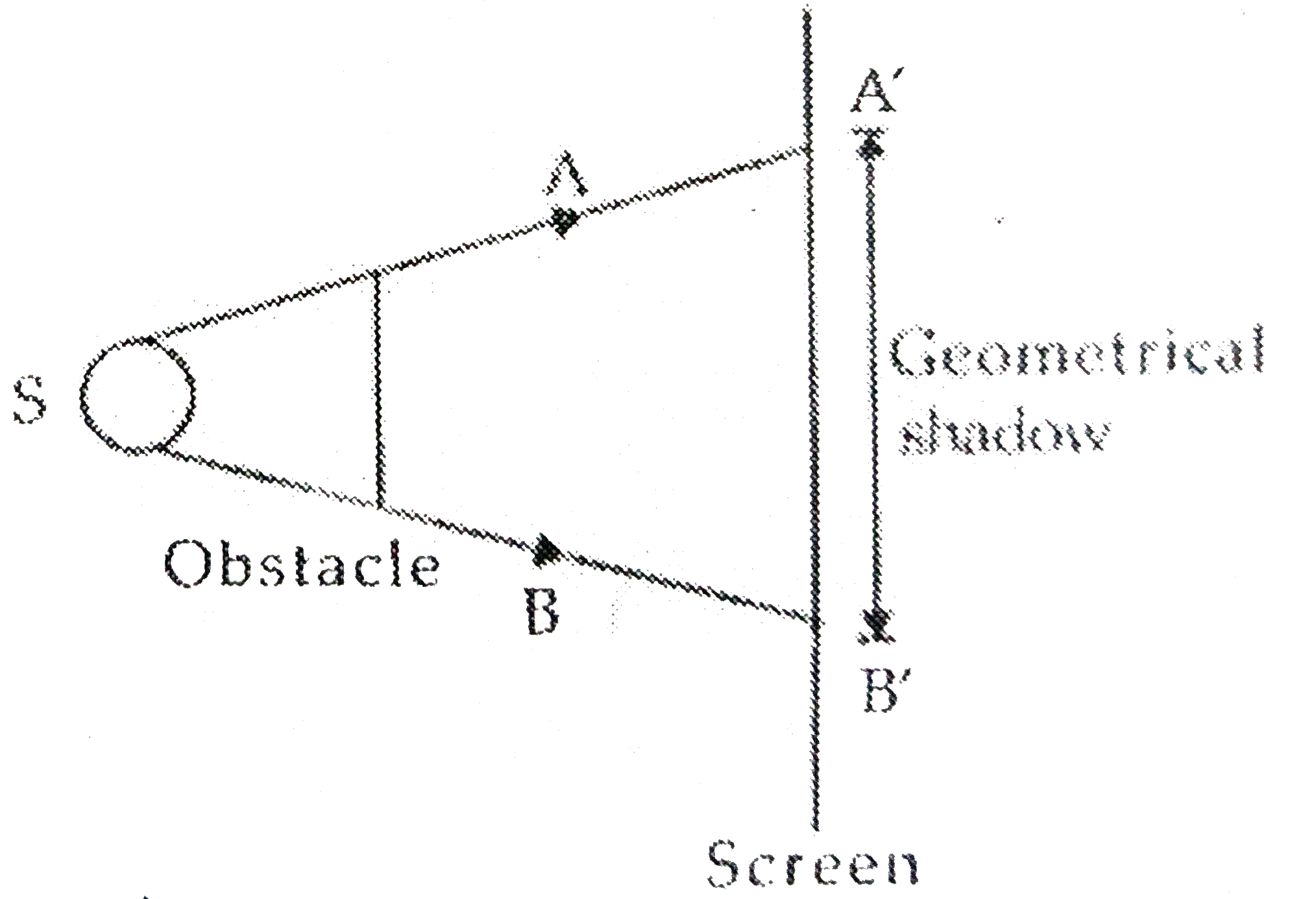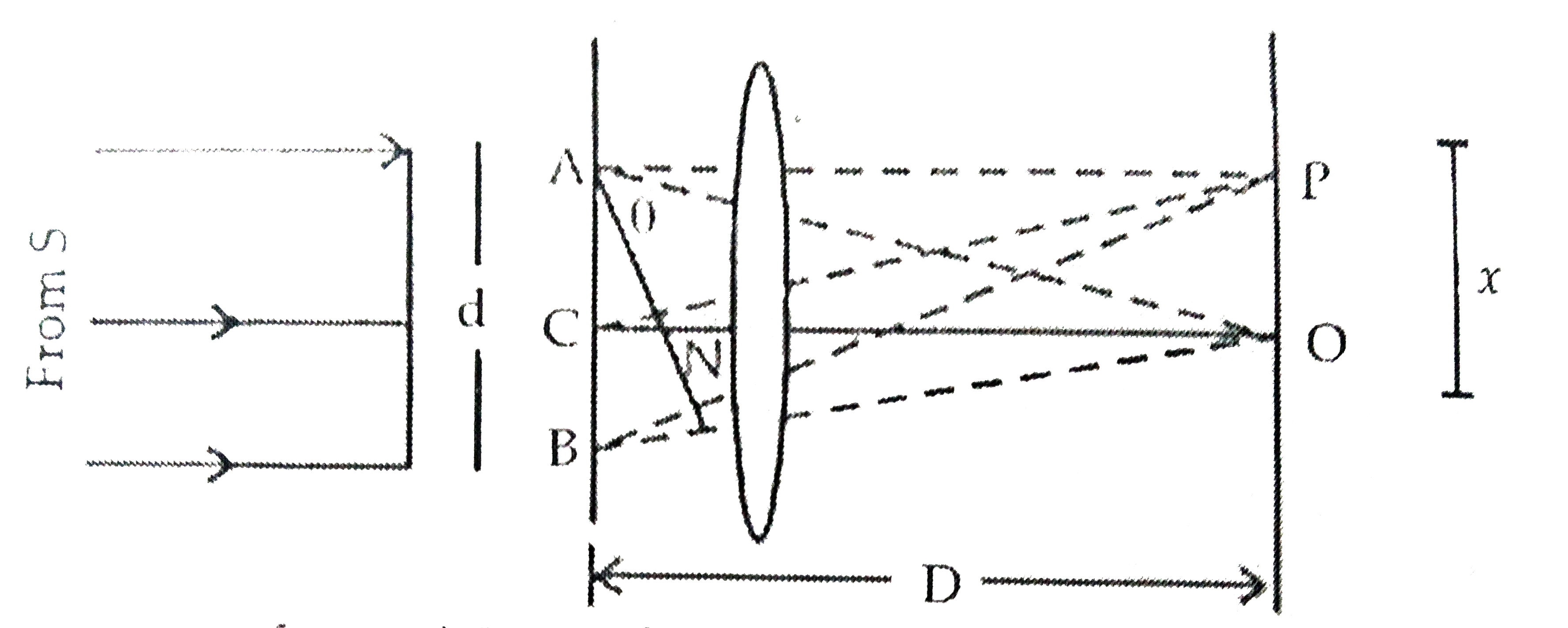(a) Describe briefly how a diffraction pattern is obtained on a screen due to a single narrow slit illuminated by a monochromatic source of light. Hence obtain the condition for the angular width of secondary maxima and secondary minima.
(b) Two wavelengths of sodium light of 590 nm and 596 nm are used in turn to study the diffraction taking place at a single slit of aperture m. The distance between the slit and the screen is 1.5 m. Calculate the separation between the positions of first maxima of the diffraction pattern obtained in the two cases.
(a) The phenomenon of bending of light round the sharp corners of an obstacle spreading into the regions of geometrical shadow is called diffraction.


Expression For Fringe Width : Consider a parallel beam of light from a lens failing on a slit AB. As diffraction occurs, the pattern is focused on the screen XY with the help of lens L2. We will obtain a diffraction pattern that is a central maximum at the centre O flanked by a number of dark and bright fringes called secondary maxima and minima.
Central Maximum : '' Each point on the plane wave front AB sends out secondary wavelets in all directions. The waves from points equidistant from the centre C lying on the upper and lower half reach point O with zero path diffference and hence, reinforce each other, producing maximum intensity at point O.
Positions and Widths of Secondary Maxima and Minima : Consider a point P on the screen at which wavelets travelling in a direction making angle theta with CO are brought to focus by the lens. The wavelets from points A and B will have a path difference equal to BN.
From the right angled , we have:
Suppose
Then, the above equation gives
Such a point on the screen will be the position of first secondary minimum.
If
Such a point on the screen will be the position of second secondary minimum.
In general, for nth minimum at point P
If yn is the distance of the nth minimum from the centre of the screen, from right angled ACOP, we have:
In case is small, Equations (iv) and (v) give
Width of the secondary maximum,
is independent of n all the secondary maxima are of the same width .
If from equation (i), we have :
Such a point on the screen will be the position of the first secondary maximum.
Corresponding to path difference,
The second secondary maximum is produced. In general, for the nth maximum at point P,
If is the nth maximum from the center of the screen, then in angular position of the nth maximum is given by
In case is small
Width of the secondary minimum,
Since independent of n, all the secondary minima are of the same width.
(b) For first maxima of the diffraction pattern we know :
where is aperture of slit.
For small value of where y is the distance of first minima from central line and D is the distance between slit and the screen.
So,
For 590 nm,
For 596nm,
Separate between the position of first maxima .
Topper's Solved these Questions
- XII BOARDSBook:XII BOARDS PREVIOUS YEARChapter:XII BOARDSExercise:SET-II
Explore 35 Videos
- XII BOARDSBook:XII BOARDS PREVIOUS YEARChapter:XII BOARDSExercise:SET-III
Explore 25 Videos
- XII BOARDSBook:XII BOARDS PREVIOUS YEARChapter:XII BOARDSExercise:SET III
Explore 9 Videos
- SAMPLE PAPER 2019Book:XII BOARDS PREVIOUS YEARChapter:SAMPLE PAPER 2019Exercise:SECTION D
Explore 6 Videos
Similar Questions
(a) Describe briefly how a dffraction pattern is obtained on a screen due to a single narrow slit illuminated by a monochromatic source of light. Hence obtain the conditions for the angular width of secondary maxima and secondary minima.
(b) Two wavelengths of sodium light of 590 nm and 596 nm are used in turn to study the diffraction taking place at a single slit of aperture 2×10−6m. The distance between the slit and the screen is 1.5 m. Calculate the separation between the positions of first maxima of the diffraction pattern obtained in the two cases.
View SolutionTwo wavelengths of sodium light 590 nm and 596 nm are used, in turn, to study the diffraction taking place at a single slit of aperature 2×10−4m. The distance between the slit and the screen is 1.5 m. Calcualate the separation between the positions of first maximum of the diffractions patterns obtained in two cases.
View SolutionTwo wavelength of sodium light 590nm and 596nm are used, in turn, to study the diffraction taking placed at a single slit of aperture 2×10−4m. The distance between the slit and screen is 1.5m. Calculate the separation between the positions of first maxima of diffraction pattern obtained in the two cases.
View Solution(a) In Young's double slit experiment, describe briefly how bright and dark fringes obtained on the screen kept in front of a double slit. Hence obtain the expression for the fringe with.
(b) The ratio of the intensities at minima in Young's double slit experiment is 9:25. Find the ratio of the widths of the two slits.
OR
(a) Describe briefly how a diffractoin pattern is obtained on a screen due to a single narrow illuminated by a monchromatic source of light. Hence obtain the condition for the angular width of secondary maxima and secondary minima.
(b) Two wavelengths of sodium light of 590nm and 596nm are used in turn to study the diffraction taking place at a single slit of aperture 2×10−6. The distance between the positions of first maxima of the difraction pattern obtained in the two cases.
View SolutionTwo wavelength of sodium light 590nmand596nm are used in turn to study the diffraction at a single slit of size 4mm. The distance between the slit and screen is 2m. Calculate the separation between the positions of first maximum of the diffraction pattern obtained in the two cases.
View Solution(a) In what way is diffraction from each slit related to the interference pattern in a double-slit experiment?
(b) Two wavelengths of sodium light 590 nm and 596 nm are used, in turn, to study the diffraction taking place at a single slit of aperture 2×10−4m. the distance between the slit and the screen is 1.5m. calculate the separation between the positions of first maxima of the diffraction pattern obtained in the two cases.
View Solution(a) In what way is diffraction from each slit related to the interference pattern in a double-slit experiment?
(b) Two wavelengths of sodium light 590 nm and 596 nm are used, in turn, to study the diffraction taking place at a single slit of aperture 2×10−4m. the distance between the slit and the screen is 1.5m. calculate the separation between the positions of first maxima of the diffraction pattern obtained in the two cases.
View Solution(a) In what way is diffraction from each slit related to the interference pattern in a double slit experiment ?
(b) Two wavelengths of sodium light 590 nm and 596 nm are used, in turn, to study the diffraction taking place at a single slit of aperture 2×10−4m. The distance between the slit and the screen is 1.5 m. Calculate the separation between the positions of the first maxima of the diffraction pattern obtained in the two cases.
View Solution(a) Explain how the intensity of diffraction pattern changes as the order (n) of the diffraction band varies.
(b) Two wavelengths of sodium light 590 nm and 596 nm are used in turn to study the diffraction at a single slit of size 4mm. The distance between the slit and screen is 2m. Calculate the separation between the positions of the first maximum of the diffraction pattern obtained in the two cases.
View Solution(a) Write two characteristics features distinguishing the diffraction pattern from the interference fringes obtained in Young's double slit experiment.
(b) Two wavelengths of sodium light 590 nm and 596 nm are used , in turn, to study the diffraction taking place due to a single slit of aperture 1×10−4m. The distance between the slit and the screen is 1.8m. Calculate the separation between the positions of the first maxima of the diffraction pattern obtained in the two cases.
View Solution

